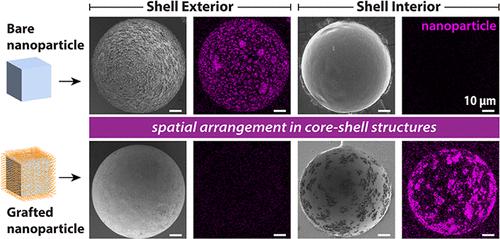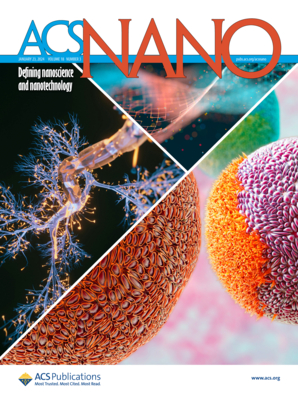Complex Core–Shell Architectures through Spatially Organized Nano-Assemblies
IF 15.8
1区 材料科学
Q1 CHEMISTRY, MULTIDISCIPLINARY
引用次数: 0
Abstract
Core–shell structures demonstrate superior capability in customizing properties across multiple scales, offering valuable potential in catalysis, medicine, and performance materials. Integrating functional nanoparticles in a spatially controlled manner is particularly appealing for developing sophisticated architectures that support heterogeneous characteristics and tandem reactions. However, creating such complex structures with site-specific features remains challenging due to the dynamic microenvironment during the shell-forming process, which considerably impacts colloidal particle assembly. Here, we describe a method to spatially deploy nanoscale assemblies within microscale structures comprising a dense shell and a liquid core through colloidal surface decoration coupled with emulsion-based synthesis. Exploiting a spectrum of nanoparticles grafted with incrementally varying densities of organic ligands, we reveal that nanofeatures can be selectively sculpted onto the shell exterior, within the shell wall, and on the interior surface. The versatility of this mechanism is validated by systematically arranging nanoparticles with various compositions, shapes, and dimensions. Spatially integrated nanotitania endows the core–shell structures with localized photocatalytic abilities. Additionally, distinctive surface modifications enable the simultaneous yet independent implantation of diverse nanoparticles, yielding intricate architectures with programmable functions. This generalizable approach showcases a synthetic strategy to attain structural complexity and functional sophistication reminiscent of those of biological systems in nature.

求助全文
约1分钟内获得全文
求助全文
来源期刊

ACS Nano
工程技术-材料科学:综合
CiteScore
26.00
自引率
4.10%
发文量
1627
审稿时长
1.7 months
期刊介绍:
ACS Nano, published monthly, serves as an international forum for comprehensive articles on nanoscience and nanotechnology research at the intersections of chemistry, biology, materials science, physics, and engineering. The journal fosters communication among scientists in these communities, facilitating collaboration, new research opportunities, and advancements through discoveries. ACS Nano covers synthesis, assembly, characterization, theory, and simulation of nanostructures, nanobiotechnology, nanofabrication, methods and tools for nanoscience and nanotechnology, and self- and directed-assembly. Alongside original research articles, it offers thorough reviews, perspectives on cutting-edge research, and discussions envisioning the future of nanoscience and nanotechnology.
 求助内容:
求助内容: 应助结果提醒方式:
应助结果提醒方式:


